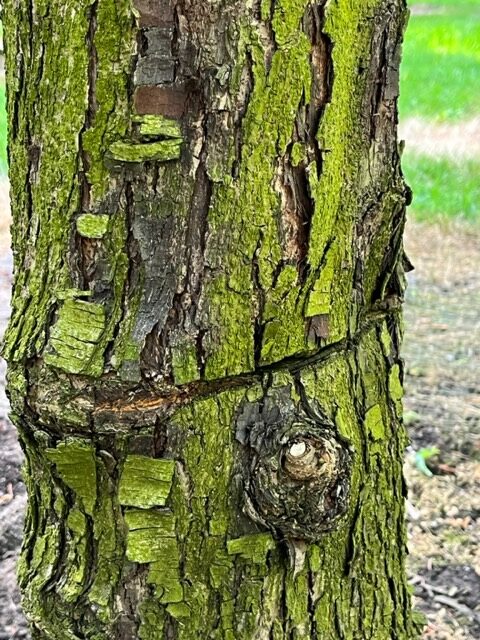Honeycrisp Ancestry
Apple Tree Photos
Dwarf and Semi-dwarf Tree Fruit
Water Core in Apples
Cedar-Apple (Juniper) Rust Apple Trees
Apple Storage
Rooting above the Graft Union (Scion Rooting)
Notching/Scoring Trees
Solving the Honeycrisp Apple Ancestry Mystery April 4, 2022
By Chuck Heisinger
Reprinted with permission by the Source: College of Food,
Agricultural and Natural Resource Sciences, University of Minnesota
MINNEAPOLIS/ST. PAUL (04/04/2022) — Ancestry tests aren’t just for people or
pets anymore. Thanks to DNA-based tracking, researchers at the University of
Minnesota have finally traced the family tree of the Honeycrisp apple — one of the
top ten varieties produced in the United States.
Recently published in HortScience, the findings are the result of sifting through
thousands of DNA markers to unwind the pedigrees of many of the U of M’s best
apple cultivars. Researchers were able to follow the roots back to European
ancestral varieties and the first days of the U of M apple breeding program, which
began in 1908 at the Horticultural Research Center. Since then, the program has
introduced 28 cultivars, including Honeycrisp, and those sold under the Zestar!,
SweeTango, First Kiss and Rave trademarks.
In the program’s early years, researchers collected seeds from orchards around the
state in hopes of finding new cultivars that could not only survive, but thrive in
Minnesota’s harsh winters. Even though controlled breeding began in 1916, non-
standardized practices and fragmentary documentation left many ancestries up for
interpretation. Now, with readily available DNA markers from around the world,
the chance to solve the Honeycrisp ancestry mystery was within reach.
Former University graduate student and postdoctoral researcher Nicholas
Howard, now an apple breeder in the Netherlands, first developed ancestry
tracking techniques using DNA markers to determine the true parents of
Honeycrisp as part of his dissertation research. Through an exhaustive,
collaborative effort with University apple breeders Jack Tillman, David Bedford
and Professor Jim Luby, Howard attempted an Herculean task — documenting the
pedigree of all 28 University apple cultivars.
He enlisted numerous national and international collaborators to assemble a
database of DNA fingerprints for over 6,000 apple cultivars based on over 10,000
Single Nucleotide Polymorphism (SNP) markers. Additionally, he tapped Ana Poets
and Kevin Silverstein of the Minnesota Supercomputing Institute to develop custom
software that could help uncover genetic relationships between cultivars by tracking
pieces of DNA shared by relatives through multiple ancestral generations.
“A large collaborative database effort, combined with new genetic techniques,
allowed us to identify the specific parents, grandparents and even more distant
ancestors of U of M cultivars,” Howard said. “Based on these analyses we could
confirm, correct or complete the parentage of 16 of the 22 cultivars introduced
between 1920 and 1991.”
The researchers found:
There were two pervasive founding ancestors in Honeycrisp’s family tree.
‘Duchess of Oldenburg’ (a Russian cultivar introduced to Minnesota in the late 19th
century) was an ancestor of overwhelming importance, appearing in the pedigrees
of 27 out of 28 University cultivars.
‘Reinette Franche,’ a French cultivar that appears not only in Honeycrisp’s family
tree (as well as several other University cultivars) but also that of many historically
important and commercially relevant cultivars, such as Gala and Golden Delicious.
The next step for the researchers is to explore the family tree even further,
connecting thousands of cultivars across the globe, as well as identifying genomic
contributions from ‘Duchess of Oldenburg’ and ‘Reinette Franche’ to highlight
regions to target for future selection.
“Extended pedigrees will be very useful to breeders in determining future crosses,”
Luby said. “The more we know about their ancestry, the better we can predict the
inheritance of desirable traits based on that DNA-confirmed ancestry — which
provides a useful feature for nurseries and apple growers when promoting their
products.” This research was partially supported by the Minnesota Agricultural
Experiment Station with funding from the USDA National Institute of Food and
Agriculture (NIFA).
Apple Tree Photos

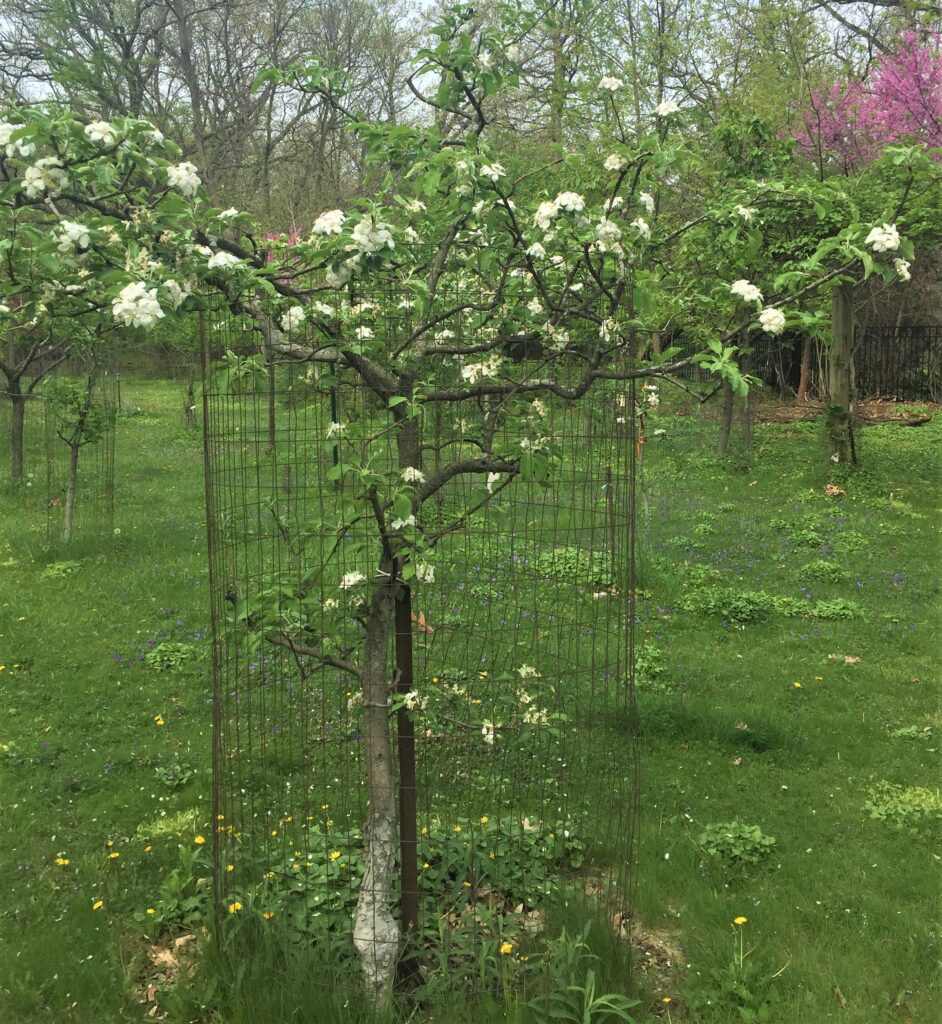
Fruit Harvested from Dwarf and Semi-dwarf Trees
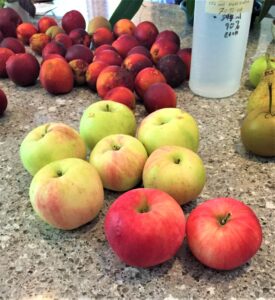
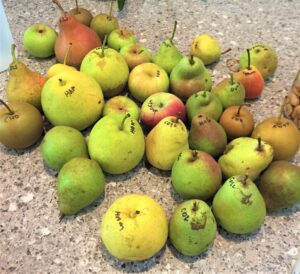
European Pears; Collette, Rescue, Magness, Duchess.
Asian Pears; Hamese, Chojuro, Kosui.
Apples; Wyjcik, Cox Orange Pippin
Water Core in Apples
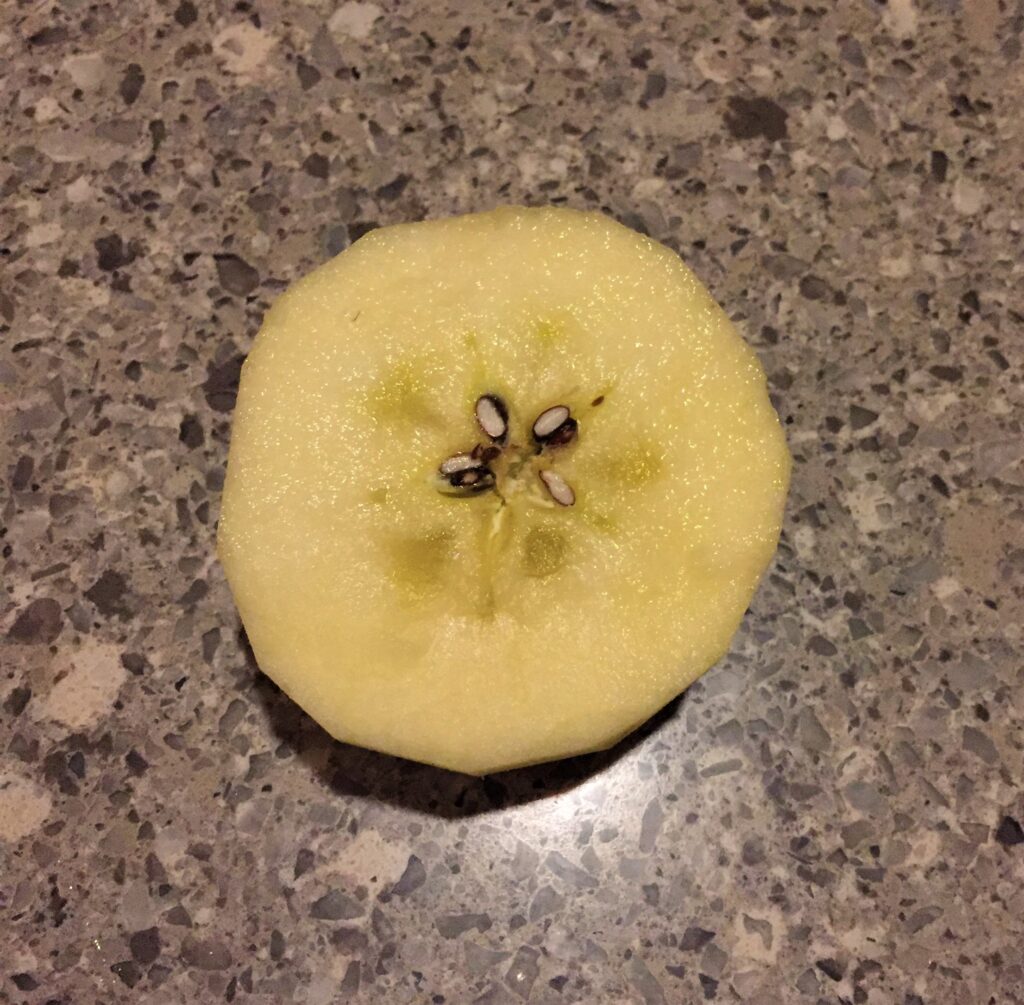
Water core is an interesting condition found in some apples. It is characterized by areas of the apple flesh having a glassy or translucent appearance. This may often occur in and around the apple core, but may extend further into the flesh or even outward to the skin. It is the result of large amounts of a type of sugar (sorbitol) being deposited near the apple core. This develops especially in apples that are harvested at full ripeness or shortly thereafter.
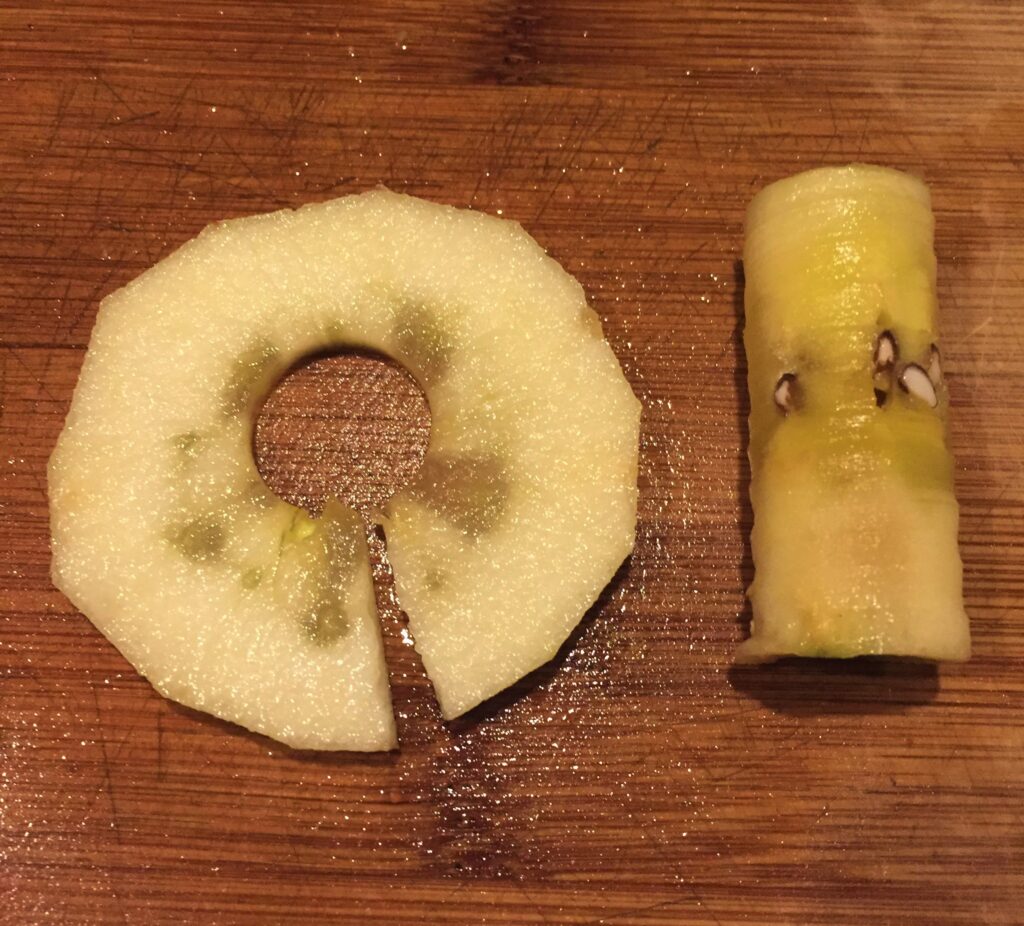
The elevated sugar concentration draws water into the core by osmosis and this causes the soaked, glassy appearance.
Such fruit is entirely crisp and edible. It will actually be sweeter than usual. The downside is that the length of storage of such apples is diminished. For home growers, this may not be a problem, but for commercial growers, who may store apples for many months, it can be. Water core can be avoided simply by picking fruit earlier.
https://hortnews.extension.iastate.edu/faq/flesh-near-centers-my-apples-has-glassy-appearance-why
________________________________________________________________________________________________________________
Cedar-Apple (Juniper) Rust in My Apple Trees
Reprinted from Grapevine, Fall 2014, vol. 38, #3
Bob Walter
August 20, 2014
I have about 44 apple trees in my yard and have been seeing a lot of cedar-apple rust this year. Last year there was a little, but this year it is much worse. This is probably due to the increasing numbers of juniper-type trees being planted by neighbors in recent years and also to weather conditions this spring and summer.
What causes cedar-apple rust? The Purdue Extension says that this disease is part of a group of fungal diseases of apple called Juniper Rusts caused by Gymnosporangium juniperi-virginianae. This includes cedar-apple rust, cedar-quince rust, and cedar-hawthorn rust. Some apple varieties may be resistant to one rust disease, but susceptible to another.


How much damage can it do to apple trees? In extreme cases, it can kill the tree. However, in less extreme cases, it will damage some leaves and possibly some fruit, but will not stunt the tree or stop it from bearing fruit year to year.
What is its life cycle? Juniper rust requires 2 hosts for its life cycle, a juniper (like eastern red cedar, Chinese juniper, creeping juniper, or Rocky mountain juniper) and an apple. Spores produced on apple trees will only infect junipers and spores produced on junipers will only infect apple. To be more exact, spores germinate on junipers eventually producing galls. When it rains during spring or summer, these galls produce and release basidiospores which infect buds, flowers, and young leaves of apple trees. One to two months later, these infected sites release aeciospores during dry weather which infect junipers to complete the cycle.
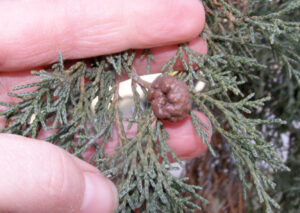
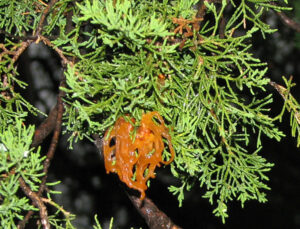
What can you do about this disease? Remove junipers in the vicinity, remove infected fallen leaves from apples in fall, use fungicides in spring to prevent infection of flowers, fruitlets, and young leaves (tight cluster to first cover). Or, better yet, grow resistant varieties of apple and of juniper!
By the way, now’s a good time to mention that if you sign up for our newsletter, you’ll get notifications for events (for both members and ones that are free to the public) and other fruit related content, often from experts like myself.
The good news is that there are a number of apple varieties that are clearly resistant to the fungus. There is a lot of information, mostly from university agriculture schools, showing the expected susceptibility of different apple varieties to juniper apple rust as well as other microbial diseases like apple scab, fire blight, and powdery mildew. Here are some links to a few informative webpages:
Cornell IPM webpage
https://ecommons.cornell.edu/bitstream/handle/1813/43082.2/cedar-apple-rust-FS-NYSIPM.pdf?sequence=5&isAllowed=y
Purdue Ag Service
https://www.extension.purdue.edu/extmedia/BP/BP-132-W.pdf
University of Minnesota Extension
https://extension.umn.edu/plant-diseases/cedar-apple-rust#managing-rust-on-apples%2C-hawthorns%2C-and-other-plants-in-the-rosaceae-family-1172760
University of Illinois Extension
http://urbanext.illinois.edu/focus/index.cfm?problem=cedar-rust-differences
Even though variable resistance to CAR is well known, it is still surprising to see the differences between resistant and susceptible varieties so clearly illustrated in your own trees.
I scored the degree of infection based on how many of the distinctive, yellow-brown or orange-brown spots I saw on leaves of my trees on August 19. The leaves of some trees were completely devoid of spots and these trees were scored as “VR” or Very Resistant. The leaves of others were covered with spots, with 5-15 spots on each leaf these were scored as “VS” or Very Susceptible to cedar apple rust. Depending on how many infected spots were seen, other trees fell in between these extremes.
The degree of infection in my trees was mostly in line with the published ratings, but a few varieties were different than expected like Jonagold (supposed to be Resistant) which showed heavy infection (VS) in my trees and Zestar! (supposed to be Susceptible) which showed strong resistance (VR) in my trees. Also, I have a number of varieties that weren’t rated online (not an exhaustive search however), but I rated them in my orchard.
VR = Very Resistant to Cedar Apple Rust
R = Resistant
S = Susceptible
VS = Very Susceptible
Here is what I saw in my yard and the Resistance/ Susceptibility ratings from Purdue and Cornell:
| My Orchard | Purdue Extension | Cornell IPM | |
| Ashmeads Kernel | VR | ||
| Calville Blanc | R | ||
| Cameo | S | S | |
| Chenango Strawberry | VR | ||
| Cox Orange Pippin | VR | ||
| Enterprise | VR | R | |
| Esopus Spitzenburg | VR | ||
| Fameuse | VR | ||
| Fiesta | VR | ||
| Fireside | VR | ||
| Freedom | VR | R | |
| Fuji | VR | ||
| Golden Russet | R | ||
| Goldrush | R | S | |
| Granny Smith | VR | R | |
| Hawaii | VR | ||
| Holiday | R | ||
| Jonagold | VS ** | R | S |
| Kinsei | VR | ||
| Liberty | VR | VR | VR |
| Mutsu | S ** | S | S |
| Newtown Pippin | VR | R | |
| Northfield Beauty | VR | ||
| Pound Sweet | VR | ||
| Rubinette | VR | ||
| Smokehouse | R | ||
| Summer Rambo | VR | ||
| Suncrisp | R | S | |
| Sweet 16 | VS ** | ||
| Swiss Orange | VR | ||
| Tompkins King | VR | ||
| Tydeman’s Late Orange | VR | VR | |
| White Astracan | VR | ||
| Williams Pride | VR | VR | |
| Wyjcik columnar (MacIntosh) | VR | R | VR |
| Winesap | VR | R | |
| Yellow Transparent | R | R | |
| Zabergau Reinette | VR | ||
| Zestar! | VR | S |
Notes:
It doesn’t seem to matter where the trees are located in my yard as to how heavy the infection is. There are heavily infected trees right next to uninfected trees.
The infection is seen all over the tree, not just on lower branches or high branches, not different on east, west, north or south sides of the trees.
Some trees get more sun than others, but this doesn’t seem to matter either.
The most highly infected trees are Jonagold, Mutsu, and Sweet 16.
The newer apple varieties that have been bred for disease resistance such as Enterprise, Fireside, Freedom, Liberty, Williams Pride, and Zestar! appear to be quite resistant to juniper (cedar) apple rust.
Apple Storage
Thanks to Mike Modde for this interesting article on the storage of apples.
Reprinted from the Grapevine, September 2018, Vol. 42, #3.
By all rights, we shouldn’t be eating apples in the dead of winter. Every bite you take from that juicy Honeycrisp is an affront to Mother Nature. We are defying her will and her seasons. But it’s fantastic. You probably don’t often consider how miraculous it is that you’re able to enjoy almost any kind of apple at any time of the year, but it’s a gosh-darn scientific marvel. During the off-seasons, you’re actually buying apples that are up to a year old, and you barely notice. A winter tomato is mealy and flavorless, but an apple hardly seems to lose any of its crunch in the intervening months. In the U.S., we’re mostly harvesting apples from July to October, and nearly all of them come from the Northeast and Northwest parts of the country.
Yet, we can eat them year-round all across the nation. A small percentage of our apples get imported from the southern hemisphere, where they’re still growing throughout our winter, but for the most part, we’re just eating old–yet still tasty–apples.
Step 1: Harvest once it’s mature, but before it’s really ripe
Apples will continue to ripen off the tree, but they have to get to a crucial stage first. The fruit’s taste comes from many different compounds, but the key one is sugar (yes, even in tart apples). An unripe apple is full of starch, which doesn’t taste very good. Over time though, the apple starts to produce ethylene gas and this triggers its own ripening process, whereby starch is converted into sugar. A fully ripe apple has replaced virtually all of its starch with sugar, but once that conversion is complete, the fruit also starts to go mushy.
Incidentally, it’s the same with bananas. A ripened banana tastes sweeter because it’s completed its sugar conversion, whereas a green banana tastes bland and starchy. An unripe apple would be similarly bland, but no grocery store sells unripe apples.
If you’re harvesting apples to eat right away, you want to leave an apple on the tree as long as possible. For long-term storage, the key is to halt the process when the fruit is just about to begin converting, but hasn’t yet begun. You can actually test for this conversion by splitting open an apple and applying iodine. The iodine will stain starch a dark blue, but won’t stain sugars, so a piece of fruit that’s dyed blue hasn’t ripened yet. Not every apple on a tree (much less a whole orchard) will ripen at the same time, but cracking open a single fruit can give you some sense of how your harvest is coming along.
Step 2: Deprive the fruit of oxygen and warmth
Cold temperatures slow down the ripening process by slowing down chemical conversion of starch to sugar. This is why apples kept in the fridge will stay fresh for longer. Farmers can keep their fruit in plain old cold storage for month or two, but most apple varieties won’t keep well much longer than that. Eventually, they’ll ripen up on their own, cold or not.
Modern consumers need their apples to last a lot longer than that though. We want Royal Galas in February, long after orchards are productive. Farmers meet that demand by essentially preventing the apples from breathing. Yes, apples breath–they take in oxygen and convert it to carbon dioxide. So, to keep the fruit from aging, we can just lock them in a room and drop the oxygen level from about 21% to 2.5% or lower. That’s low enough that some workers have died because they weren’t wearing proper safety gear. Remember, if it’s oxygen-deprived enough to put an apple into a coma, it can probably put you in one, too.
Of course, other gases can still swirl around in there, and the ripening process can’t be stropped entirely. But, with low oxygen and cool air, farmers can make their harvest last for months longer than it really should. But make sure not to lower the oxygen too much. If you compleely deprive them, apples start fermenting instead, and you end up with alcoholic fruit. Great for cider-making, not so great for eating.
Step 3: (optional): Actively prevent ripening.
If you really want to stop an apple from maturing, there’s always SmartFresh. That’s the brand name for 1-methylcyclopropene, which binds to an apple’s ethylene receptors, thereby preventing it from getting the signal that it’s time to ripen. You can also use SmartFresh between the time when the apples are pulled from storage and when they arrive at grocery stores. With a ton of apples in one place, the buildup of ethylene gas could cause all that fruit to ripen rapidly and ruin a harvest on the way to the store.
Step 4: Let the ripening begin!
Once you take the fruit out of the the cold and let it produce ethylene, the apples start ripening again. The starches become sugars, the skin loses its bright green hue (unless it’s a Granny Smith), and the fruit develops its characteristic flavor.
The problem growers are still trying to solve is that the ripening doesn’t develop exactly the same way off the tree as it does on. A lot of the apple’s flavor will survive long-term storage, especially sweetness (that’s just dependent on sugar development). But the more rounded, complex flavors come from esters, the chemical compounds that give an apple it’s apple-y aroma. On the tree, an apple develops an array of esters. In storage though, it doesn’t have access to all the same nutrients and gases as it does in the orchard. It can’t develop that whole array, and so doesn’t have the same full-bodied flavor.
That said, you probably don’t notice this as much with apples as you do with something like tomatoes. A tomato doesn’t really ripen well off the vine, it’s just that growers and grocers are good at essentially faking ripeness. Most consumers judge a tomato in the store based on its redness. Application of ethylene gas will turn even the greenest tomato red, but it can’t make a tomato taste like a tomato. That’s why you should select them based on how they smell not how they look. A vine-ripened fruit has a distinct tomato-y aroma, while an off-season one smells like almost nothing.
But we’re way better at ripening apples. A fresh apple in summer tastes great, but by the time winter rolls around, all you have to compare your apples to is other old apples–and they all taste fine, if not amazing. Really, we should just be thankful that we have apples in February at all, much less tasty ones. We’ve spent generations breeding apple varieties that stay crisp and store well, and now we’re reaping the rewards.
Happy Eating!
Rooting above the Graft Union (Scion Rooting)
For trees grafted to dwarfing rootstocks, occasionally the scion (above the graft union) will send out roots into the ground. This is a problem. Direct rooting of the scion into the ground will obviate the use of the rootstock. Rootstocks are used for several reasons including:
1. To reduce the final height and girth of the tree,
2. To speed up the length of time required for fruiting, and
3. To confer resistance to certain fungal and bacterial root diseases.
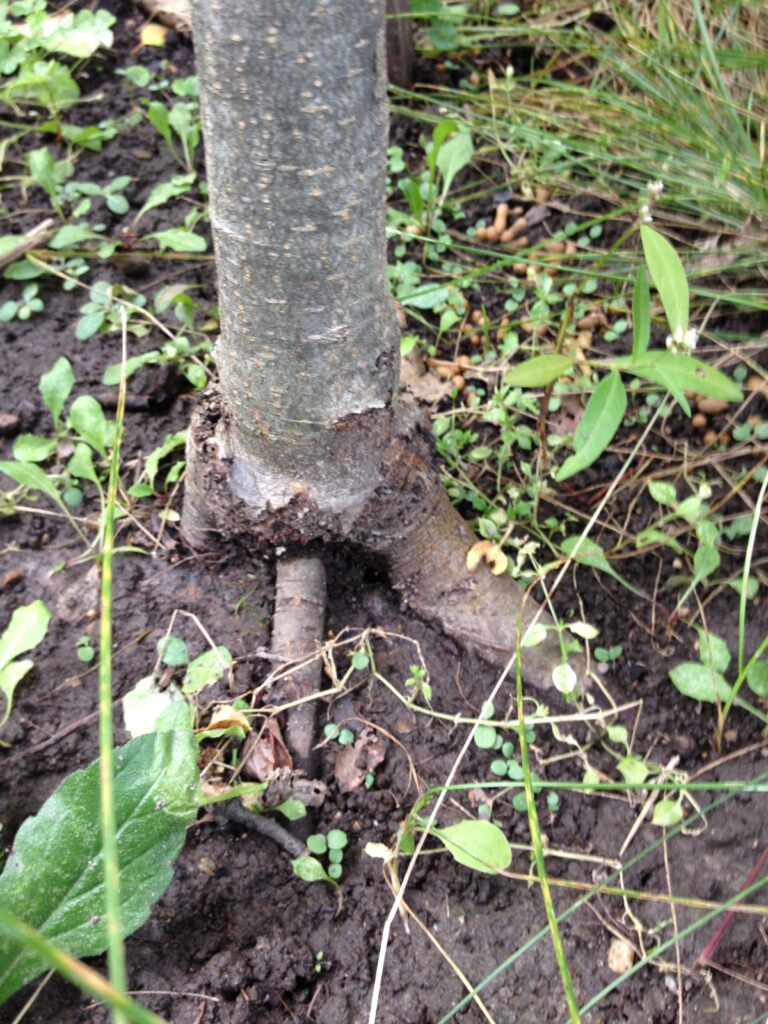

When scion rooting occurs, the tree starts to grow much faster, flowering is delayed or ceases, and fruit production is delayed or stopped.
This Hawaii apple had been grafted onto M27 rootstock and planted. After 4 or 5 years, the tree had grown to 5-6 feet in height and had started to flower and produce fruit. In years 8 and 9, however, the tree stopped fruiting and started showing a great deal of vigor seen as abundant new shoot growth. When the soil was pulled away from the base of the tree to expose the roots, it was clear that the graft union was below ground level and that the scion had rooted. If the tree had been allowed to continue growing after scion rooting, it would have attained the height of a full-sized apple tree (about 20-25 feet tall) and would not have resumed fruiting for several years. However, the space required for this was not available.
Rather than destroy the tree and replant another dwarf tree, the scion roots were cut off and the scion graft union was kept above soil level. The excessive top growth was pruned off and the tree was allowed to continue growing.
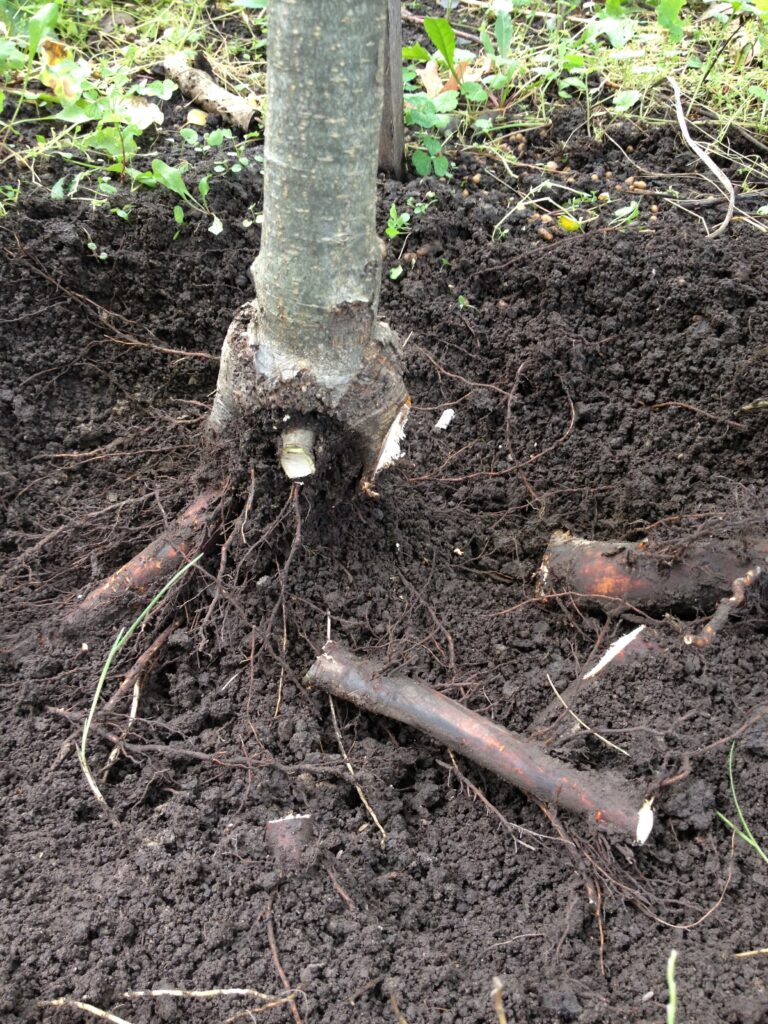
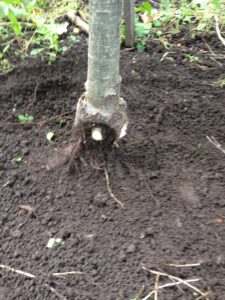
The Hawaii tree resumed the less vigorous growth habit of a dwarf tree. In the second season after pruning away the scion roots, the tree again bloomed and bore fruit. So, scion rooted dwarf trees can be salvaged if the scion roots are removed and the graft union is monitored in the future to make sure that it is kept above ground level.
Notching/Scoring Trees
Done to encourage fruiting.
